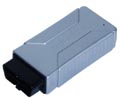- Adaptations DDE7
- |
- BMW Electronic Systems
- |
- Technical Info
- |
- Car Tech Info
- |
- MicroTronik
adaptations for Diesel Electronics DDE7 control System

For Diesel Electronics DDE7, there are four adaptations for various functions:
· Adaptation of mass air flow meter
· Mean quantity adaptation
· Adaptation of EGR valve
· Adaptation of swirl-flap actuator
These adaptations are described in the following section.
In normal operation, the air mass flow meter is subject to effects such as soiling and aging. Those effects cause divergence between the saved characteristic and the specified status resulting in symptoms such as lack of power or black smoke. In order to prevent the effects of this problem, the (Air mass flow meter adaptation) function has been introduced.
Air mass flow meter adaptation is performed by the DDE control module at two operating points: When idling and under load in an operating range defined as follows:
· Engine speed = 1700 - 3000 rpm
· Charge-air pressure = 1100 - 2800 mbar
· Speed = 90 - 160 km/h
· Change in intake-air temperature less than 2 Deg C/s
· Delay period = 3 s
Adaptation sequence at each of those points:
The air mass flow meter adaptation uses certain operational data to calculate the theoretical air mass flow passing through the engine. The DDE control module compares the figure obtained with the level measured by the air mass flow meter.
If the DDE control module finds that the measured level differs by more than ± 8 % from the theoretical figure, that difference is saved on the control module as an adaptation value. As the adaptation is carried out in two operating points, there are two adaptation values.
These adaptation values enable the control module to adjust the measured levels before they are processed by the various functions.
Application
The service function Mass air flow meter adaptation must be run if the mass air flow meter is replaced.
The saved compensation factors are reset to 0 in the process.
An oxygen sensor is required for the quantity mean value adaptation function. This sensor is fitted after the turbine of the exhaust turbocharger. The oxygen sensor is a wide-band sensor that provides exact lambda values over a wide measuring range. The quantity mean value adaptation is a learning procedure in which the fuel-air ratio (lambda value) is correctly adjusted by adapting the air mass or exhaust gas recirculation rate.
This procedure does not affect the individual injectors.
The lambda value measured by the oxygen sensor and the air mass measured by the HFM are used to determine a mean fuel injection rate across all cylinders. This value is compared with the injection quantity specified by the DDE control module. If there is a deviation, the air mass is adapted to the actual fuel injection rate by adjusting the exhaust gas recirculation valve in such a way that the correct lambda value is set.
The MMA is not a rapid control operation, rather an adaptive learning procedure. That means that the fuel injection rate fault is learned in an adaptive characteristic map that is saved permanently in the DDE control module.
Application
The service function (quantity mean value adaptation) must be run if one of the following components was replaced:
· Mass air flow sensor
· Rail pressure sensor
An adaptation value is saved in the DDE control module for the EGR valve with move-away report. This adaptation value describes the position of the end stop of the exhaust gas recirculation valve.
Application
The service function (adaptation exhaust gas recirculation valve) must be run if the EGR valve was replaced.
The service function must be run before replacing the EGR valve.
Execution of the service function deletes the adaptation value. After installation of the new EGR valve, the new value is learned and saved in the DDE.
An adaptation value is saved in the DDE control module for the electrical swirl-flap actuator. This adaptation value describes the position of the end stop of the swirl-flap actuator.
Application
The service function (swirl-flap controller adaptation) must be run if the swirl-flap controller is replaced. The service function must be run before replacing the swirl-flap actuator.
Execution of the service function deletes the adaptation value. After installation of the new swirl-flap actuator, the new value is learned and saved in the DDE.
For correct monitoring of the power consumption of the electrical fuel pump, an adaptation value is saved in the DDE control module. The electrical power consumption of the fuel pump at minimum activation is saved with this adaptation value.
The lower limit value for monitoring the power consumption of the fuel pump is calculated with this adaptation value.
Application
The service function (Electric fuel pump adaptation) must be carried out if the high-pressure pump is replaced.
The reason is that the high-pressure pump has a major influence on the power consumption of the electrical fuel pump.
Execution of the service function deletes the adaptation value. After installation of the new high-pressure pump, the new value is learned with the engine running and saved in the DDE.
For better rail pressure control, the characteristic curve of the rail-pressure regulating valve is adapted.
Application
The service function (rail-pressure regulating valve adaptation) must be run if the rail-pressure regulating valve is replaced.
Execution of the service function deletes the adaptation value. After installation of the new rail-pressure regulating valve, the new value is learned with the engine running and saved in the DDE.
is one of the best Professional scan tools to for BMW; Autohex allows you to diagnose, code, program/flash ecus, replace with used ECUs, and add new keys for BMW. For more information: BMW Scan Tool
GDS KIA Ecu Flashing using AutoHex II


